By John Bocskay
Any American or Canadian who has been to a Costco in Korea has witnessed what Koreans do with the onions. In the U.S. you turn the crank on the dispenser and catch the tumbling onions on the hot dog, the whole hot dog, and nothing but the hot dog, but that’s not how the Koreans roll. Most of them pile the onions on a dish or a patch of foil, dump globs of ketchup and mustard over them, mix it all into a lumpy orangey mash, and tuck straight into it with fork and spoon as an improvised side dish to their pizza, clam chowder, or Caesar salad.
Expat critics react with a mix of condescension, bemusement, derision, and disgust. Didn’t Koreans get 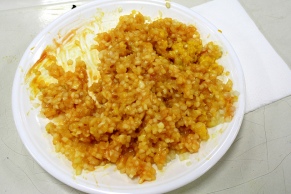 the memo? Onions are supposed to go on the hot dogs! And look how many onions they’re piling on! Have they no shame?
the memo? Onions are supposed to go on the hot dogs! And look how many onions they’re piling on! Have they no shame?
Among the many unfair and uncharitable assessments of this practice, perhaps the most ironic and ridiculous is the notion that Korean shoppers are taking advantage of the generosity of Costco, a fantasy that would have us imagine Costco to be a defenseless multinational corporation which is either unaware that their staff are refilling the onion dispensers 30 times a day on weekends (I asked) or are somehow powerless to stop this hemorrhaging of onions; a fantasy which depends for its dramatic tension on the belief that despite giving away samples of ribeye steak, shrimp, wine, pork cutlets, sausage, noodles, cookies and dozens of other items every day at stations all over the store, the thing that’s going to finally bust them and ruin the party for everyone is the unfortunate habit of doling out a few sacks of one of the cheapest vegetables on the planet.
If that argument sounds lame, you may find yourself suspecting, as I do, that what’s more likely happening is that Costco Korea has lucked into an inadvertent but tolerable solution to their lack of side dishes in a country that everywhere expects them, and that management has decided to run with it as long as it doesn’t lose too much money.
A recent e-mail exchange with Edward Yoon Kim, the General Merchandise Manager for Costco Korea confirmed my hunch. Noting that the company believes that “real success comes from real member satisfaction,” Mr. Kim explained that as long as Costco can make a “reasonable profit” while making customers happy they would continue offering free onions, and that if it was no longer profitable to do so they would consider stopping it. Since the onion salad buffet has been going strong for several years, it seems safe to call it something other than abuse.
There’s a lot about these criticisms that has always struck me as strange. The first thing you might notice at Costco is that there is nothing posted on the onion dispenser itself to indicate that the onions are supposed to go on hot dogs or that they are not intended as a side dish. In other words, there was no ‘memo’ that Korean customers are not getting, and the habit that our worldly Western critic imagines to be a self-evident universal truth turns out to be nothing more than his own narrow cultural conditioning.
Nor is there anything intrinsic to the onion dispenser to suggest that the culturally-conditioned way that Americans use it – cranking steadily with one hand while catching an uneven flow of onions atop a narrow moving target with the other hand – is even the best way to use it. In the 20 minutes that I observed people serving 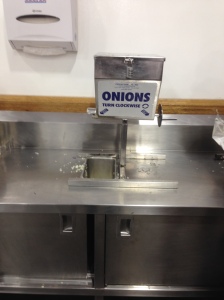 themselves onions on a recent Saturday afternoon, the only people who dropped onions onto the counter – apart from the one little kid who cranked it for fun until his mom told him to cut the shit – were the ones who used it the “right” way. Not surprisingly, nobody who used a dish to catch onions managed to miss any.
themselves onions on a recent Saturday afternoon, the only people who dropped onions onto the counter – apart from the one little kid who cranked it for fun until his mom told him to cut the shit – were the ones who used it the “right” way. Not surprisingly, nobody who used a dish to catch onions managed to miss any.
Ditto for the ketchup and mustard, which is actually harder to dispense directly onto a hot dog than the onions are, for the same reasons (uneven flow, occasional spurts, moving target, etc.), but with the added challenge of the changing distance of the hot dog to the spigot as it is pumped downward. Catching the condiments on a dish and mixing them later makes it easy and actually gives you a shot at recreating the model hot dog in the promotional photo above the food court, or failing that, just not making a total mess.
I also watched people eat for a while, and I noted that a quarter of the people (7 out of 28) who took onions were actually using them in the intended way: as a topping for hot dogs. I realized then that mixing the onions with the condiments beforehand and spreading them on as a sticky mixture made them less likely to tumble out when you bite into the dog. I also observed another 7 people put the onions on bulgogi bakes, which I mentally noted as something I definitely had to try later.
The rest treated the onions exactly the same way Koreans treat them everywhere else: as a side dish, and in order to understand that, you need posit nothing stranger or more terrible than a small cluster of reasonable assumptions based on long-standing cultural practice.
The more I think about the Costco onion salad, the tougher question for me to answer is not why Koreans do it or why Costco allows it, but why Westerners almost never see it as innovation or a clever adaptation and instead tend to paint it as a failed attempt at cultural appropriation. And it’s a very selective tendency. Chop up a hot dog into pieces so that the family can share it and you have a charming example of Korean togetherness; but eat onions from a dish with mustard and you’re a culturally-confounded freeloader. Bump into someone in a traditional market and it’s an instantly forgettable part of the rough-and-tumble charm of the old Asia, but nudge someone with a shopping cart at an American supermarket chain and you’re destined to be the clueless antagonist in an upcoming facebook rant or K-blog screed.
I’ve long suspected that the reason we think like this (I confess to it as well) is that when you go to a place like Costco you feel you are stepping into a piece of America, so you consciously or unconsciously feel that the same norms apply. When they don’t, it’s more jarring than if the setting had been radically different and had carried no such expectations. This may be why it often seems that the hardest things for Western expats to accept are ironically not the things that are most different from our home countries but the things that are most similar. We enjoy the mad rush of a tuk-tuk ride through Bangkok’s shifty alleys yet curse the Korean driver who fails to indicate a lane change on Seoul’s modern roads. Being nudged at a street food cart is a minor annoyance, but cutting the line at a Busan Burger King inspires an aggrieved lecture. Shoot soju on a raised wooden platform in front of a bodega and you channel old-world insouciance; do the same thing on a new sidewalk and you’re an obstacle. A savage. An idiot.
It’s fun to point out cultural quirks and oddities, but it’s ironic that the cultural heirs of Thomas Edison and the Wright brothers so often insist that Koreans should think inside the box and see onion dispensers as having only one conceivable use. You can learn something about familiar things by observing how they are used by people who have no culturally conditioned ways of using them – there’s a whole genre of internet memes which fascinates millions of people for precisely this reason. It’s weird that we applaud the ingenuity of the American yokel who figured out that he can use toothpaste to clean the headlights of his pickup truck, and we dignify his achievement with the label “life hack”; but when some anonymous Korean shopper figured out that catching condiments on a dish was actually a decent idea, or that mixing them together would result in a dish that millions of people apparently enjoy, we deride it as a cultural hack job.
Perhaps the final irony is that if we insist on being purists and on recreating ethnic dishes either authentically or not at all, then we’re simply being difficult, but the more immediate problem with that is that a lot of my favorite foods – General Tso’s Chicken and New York-style pizza come to mind – would never have been created in the first place. You’d also have to say goodbye to 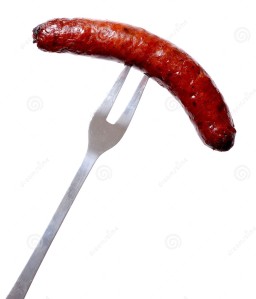 the American hot dog, which is itself a bastardization of European sausage that could not have held onions at all if Americans hadn’t added the bun. When you really get down to unpeeling the layers of assumptions surrounding the Costco onion salad, it becomes hard to know which is piled higher: the onions, or the irony.
the American hot dog, which is itself a bastardization of European sausage that could not have held onions at all if Americans hadn’t added the bun. When you really get down to unpeeling the layers of assumptions surrounding the Costco onion salad, it becomes hard to know which is piled higher: the onions, or the irony.
The only real question remaining for me concerning the onion salad is, “How does it taste?” so in the interest of the advancement of knowledge I tried it. I admit to feeling a pang of vestigial guilt when I piled the onions on my plate, plopped some mustard and ketchup down next to it, and swirled it all together. I’ll also be the first to admit that the resulting mixture really does look gross, perhaps because it bears an uncomfortable resemblance to the fake plastic vomit that was sold in the backs of comic books when I was kid.
Once I got past that, however, I found the onion salad to be surprisingly bland, not nearly as tart as I expected, but my curiosity was still only half satisfied. Fulfilling an earlier promise to myself, I cut open a bulgogi bake, loaded the onion salad on top and had a genuine Eureka moment as the flavors hit me: the combination of the breaded crust, marinated beef, cheese, onions, mustard, and ketchup transformed the ho-hum bulgogi bake into a very respectable cheeseburger, and I assume, fair reader, that you don’t need me to tell you exactly how weird and terrible that was.

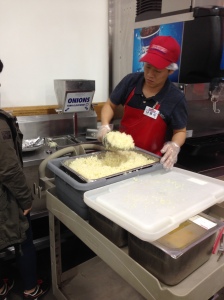

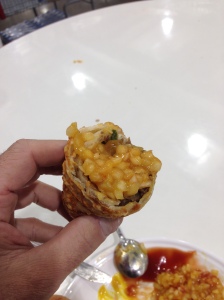
lol, it amuses me to think that somewhere in the Korean blogosphere, a netizen may be questioning why Americans messily put their onions ON hot dogs. 😛
Ha! Fair question.
Why do you care so much about junk food?
Oh yeh …’Any American or Canadian who has been to a Costco in Korea has witnessed what Koreans do with the onions.’
What a small and silly world it is that you dwell in.
I don’t care about “junk food” – I’m interested in how cultural appropriation is perceived by members of the foreign community, because I believe that caring about things like that is a small step toward making the world less small and silly.
I’ve seen rants about this before, none as amusing or level headed as yours. My thoughts were, who the hell can eat raw white onions like a side dish? I see people pull two rings off their cheeseburgers. That was long before I had watched 2+ years of Korean movies, dramas, variety and even “eating” shows. I never thought of it as “freeloading”, just stinky, hot and a little odd. Now that I know Koreans love stinky, hot and a little odd, it’s not so amazing to me anymore. Raw white onions must indeed seem “bland” to the average Korean.
Yeah. I actually eat a lot of raw onions – toegi gukbap is one of my favorite dishes, and they always serve raw onions as a side, and they seem to have a lot more flavor in those places. Thanks for reading and commenting.
I eat a lot of raw green onions, or scallions….not white onions or even red….I don’t know why they’re the “go to” onion in the US now….I like Vidalia and Mayan Sweets now since they aren’t nearly as stinky or hot….at least raw. We have a favorite mom and pop hamburger place and they use the hottest white onions on the planet…Koreans would probably love them….I always “hold the onions” in that place.
Wow: Vidalia, haven’t heard that in a while. I remember being down south and seeing an ad for them with a kid taking a bite into one like it was an apple. I like onions, but that was, wow.
They are very sweet. They claim it’s the soil and they are a “seasonal” vegetable. Now you can get the Mayan Sweets year round. They cost a bit more but they are larger than the average white onion and they are like a Vidalia….much sweeter not “hot”. Yeah I can eat them raw and people who don’t like onions find them much less obnoxious. I live in VA. That used to be the south. Now they call it a mid-Atlantic state. It doesn’t matter we still have lots of rednecks and we eat like southerners.
I’d love to get my hands on some of those here. Now you have me wondering what sort of onions they use in the food court.
Great read.
Thank you, Greg.
Nice piece John. Enjoyable reading as always and a clever topic. I will try your bulgogi bake hack.
Thanks, Bobby. “Bulgogi bake hack” – nice! I do recommend it.
i make the salad too. use some of it to top my hotdog and eat the rest as well. if there’s no kimchi, that’s the next best alternative. good topic to write about^^
Thank you.
Good piece of writing. However, after over a decade in this country, I think both you and I can agree on the broad generalization that most Koreans will eat shit-on-a-stick if it’s free. That inherently is at least as cultural as the side-dish aspect.
Hahaha
They like their freebies, sure, but I don’t see anything unique about Korea in that regard. Let’s keep in mind too that Americans trample each other to death for shit that’s merely ON SALE.
Nice work as always Herr Bocskay…really dig the notion that crossing into a given commercial space can instantly reorient one’s normative expectations regarding appropriate behavior. While reading this I fondly recalled recalled a visit my wife, her parents, and myself made to a well established doobu restaurant in the heart of Koreatown, LA. Suffice to say, after a day of traipsing around the city, my father-in-law and I were quite ready to freshen up, and proceeded to do so in a quite a ‘Korean’, or better yet Busan, style (i.e. boisterous banter and multiple bottles of soju). Alas, our fellow, largely Korean-American, diners were rather nonplussed, if not horrified, by our behavior. Nor did they requite our efforts to spread the jeong.
Ha! Yeah, sounds about right. You’re way more Korean than most of that crowd by now. Thanks for the kind words, my friend.
You truly have become one with the people John.
Just trying to understand. Thanks, Terry.
I find it bemusing that Bocskay spent a Saturday afternoon in Costco watching people eat onions. I’ve taken to ignoring how others want to enjoy the foods they choose.
Well, part of an afternoon. I also made time to do some shopping and have a calzone and a blueberry sundae (sans onions)!
Reblogged this on Johnny Engrish and commented:
A friend has written an ode to onions, Korea, and Costco. Worth checking out.
Thanks for the reblog, Johnny!
Impressive piece of writing. I dont think many people would take the time to deconstruct this kind of little cultural quirk as thoroughly as you did. And you made some excellent points in the process. Thanks for the entertaining read.^^
Thank you, Paul.
Nice piece John. I think about the first meetings between the Costco home office and the Korean branch reviewing costs. “Soooo you’re 1200% over the projected condiment budget…”
Ha! Yes, I imagine it went down something like that too. THanks.
Bloody hell. Get a hobby. Armchair anthropologist
Oh please fuck off
Armchair anthropology IS my hobby (wouldn’t “armchair” ANYTHING be a hobby by definition?), and sorry to say this, but that’s a rather rich comment from a guy who apparently spends HIS time reading and commenting on blogs he doesn’t like.
On a point of order, the manufacturers pay for the food samples at Costco and pay the lady to do it, not costco… They do it to increase sales and it works.
What would you call someone using a small paper cup intended for water to take an espresso at the newly opened IKEA without paying for it? Or buying a soda glass, and taking a coffee in it (soda is cheaper than coffee) would ‘thief’ be appropriate? Or is this just another ‘cultural difference?’
Re: the manufacturers pay for the food samples at Costco and pay the lady to do it, not costco
That’s not my understanding of how it works. Costco, not the product manufacturers, retains an exclusive event presentation company (http://en.clubdemokorea.com/?page_id=65) to provide the staff for the those events, and that, keep in mind, is a service for which Costco pays. Regarding the samples themselves, I don’t know who pays for them, though I don’t know who exactly the “manufacturer” would be for their beef, for example.
Re: your coffee analogy – If someone who had not purchased anything took something that was offered for paying customers only, I would call it stealing, but that’s not what is going on at Costco. Customers, all of whom have bought food (even granting a handful of exceptions, which I’ve never witnessed and which Mr. Kim in his e-mail to me could not even confirm), are using a condiment that has been provided for paying customers, and nowhere where they told it was only for hot dogs. You would also need to explain why Costco, who is very much aware of that practice, has decided not to stop it. When the “victim” allows it to continue for years and has essentially adopted it as an unintended but tolerable part of their overall strategy, it seems to me you have to call it something other than stealing.
Thanks for the comment.
It’s definitely not stealing–if I had to use Yiddish, I’d call it schnorring–and it’s not unique to Costco. We’ve all seen the lineups for free samples at Homeplus, E-Mart, etc. And true enough, if Costco doesn’t mind it, neither should anybody else. The equivalent would be somebody taking a crapload of relish packets from MacDonalds, and making a condiment soup with whatever was available. In the West it would be considered–at the very least–opportunistic and pretty grubby behavior. Here it’s accepted as a matter of course.
Exactly Johnny. Some people take it too far, as when many things in Korea. You sum it up well. Westerners doing this in a western country would be looked down upon, here they aren’t, It’s not life threatening so people shouldn’t be bothered by it. I find it amusing, although my wife thinks it’s being a grubby, my influence in general maybe.
(as with) and .It’s. Gee I have to proofread before I hit submit.
Ditto TJ, Paul. Anyone who has been to Costco has seen this phenomena but no one has put it down like that. I’m curious to try the salad atop a bulgogi bake, but when I go to Costco there’s only one thing: the hot dog. The second best hot dog ever (a grilled Farmer John Dodger Dog at Chavez Ravine being #1). Nice work.
Thank you, Anth.
I was very disappointed in this article. Not only did it make me very hungry, but it did not give me any directions to the nearest Costco. I hope the author will take his audience into consideration in the future… and by future, I mean in the next five minutes because now I’m positively starving!
We can take care of that, Eubie.
Thanks for the perspective. I’m guilty of pointing fingers. But, I have practiced hard at the game of hovering the moving target hotdog under the splattering condiments, and I’m proud of that! Putting it on the plate is cheating!!!
Ha! Well done, sir.
By the way, thanks for taking the time to study and disect this “odd phenomenon” and give a different perspective. I have asked Korean friends why this occurs. They said it’s either “because it’s free and it’s foolish not to take free stuff”, and “they need a side dish”.
Sure. Most people take free stuff for the same reason Edmund Hillary claimed he climbed Everest: because it’s there. I do too. Thanks for reading and commenting.
Reblogged this on Outside Looking In and commented:
My latest piece over at Sweet Pickles an Corn: on the odd practice of eating condiment onions as a side dish, and the odder habit of freaking out about it.
John,
Nice bit o’ writing. It addresses the subject matter quite well. However, for me, it did not address the single question that has been bugging me for years and years and years.
After 26 years here, there isn’t a lot (relatively) that get’s me really angry. I never stop being amused and fascinated and the differences in social norms and interactions between here and everywhere else.
As a brief aside, I have experienced, on more than one occasion, people (mostly of the older generation) standing in the onion line with their plates in hand staring at me with a slightly bewildered expression on their faces as I crank the onions and pump the ketchup and mustard onto my dog. I have even heard a few wonder amongst themselves what I am doing with the “side dish.”
As an aside to the aside, which will sort of segue back into the my burning question, by and large, Koreans don’t eat raw onions as a side dish. Sure, there will be a few slices or slivers at a Chinese restaurant with their JJaJangmyeon or with their gukbap. But you wont see Koreans eating large quantities of raw onions as a side dish, particularly in piles that would eclipse any amount of kimchi they would consume during a normal meal.
This leads back to my burning question, which is not “why is this happening,” but rather “why did this happen in the first place.” THAT is that I have always wondered and continue to wonder every time I go to Costco.
It has been going on long before Costco arrived in Busan. It was happening in the early days of the Daegu Costco many moons before Busan, which leads me to believe it is a practice that migrated from elsewhere in the country. I have confirmed that it takes place in other Korean Costco stores as well. But where did it originate? Who was “Consumer Zero?”
I image the first or second customer at the food service counter on opening day of the first Costco in Korea getting a pizza and/or bake and getting a drink. I imagine Customer Zero then sees the onion dispenser and the catchup and mustard pumps and wonders, “what is that for?” Customer Zero then turns the crank a couple of times and watches the onions fall onto the plate (or counter). Customer Zero then thinks, “Oh, this is a side dish, I guess, and the catchup and that yellow stuff must be a topping for the side dish, and that must be what they do in America.” Customer Zero then takes a bit more of the onions, lubes them up with catchup and mustard and trundles off to the table to eat lunch.
The person following Customer Zero through the drink line sees what Customer Zero has done and think, “I guess Customer Zero knows what to do, and I should follow suit or I might miss out on this experience.” That person follows Customer Zero’s example and piles on the onions and, is in turn, followed by the next person in line.
Within minutes of opening for business, a precedent has been set and a custom/tradition is born. 15 minutes or so later, when someone complains to the employees that they are out of onions, the Costco employees wonder how that is even possible. Costco employee looks around and sees what has happened and thinks, “Wow. THAT not what they are supposed to do, but it’s certainly not MY problem,” and quietly refills the onions. Thus, a precedent is set, and a custom/trend is born.
At least that is how *I* imagine it went down.
While I enjoyed the social anthropology of how natives, foreigners, and the company deals with the Great Onion Issue, it still doesn’t satisfy my curiosity about who Customer Zero was and how we all got to this point. Unfortunately, I suppose that the answers to this mystery are lost in the mists of time.
Jeff,
Great question. I agree, “Customer Zero” is probably lost in the mists of time, along with the first intrepid soul who ate an oyster, a sea urchin, fermented skate, etc. but it’s fun to imagine how it happened. Your speculation strikes me as plausible. Thanks for the thought-provoking comment! It’s nice also to know that I’m not the only person who sits around wondering about things like this.
John. You should go to Changnyeong and pay homage to the home of the modern Korean onion. They have a large golden onion sculpture on display out in the cuntryside.
I’m just not that into onions. But thanks, Will!
Costco is aware of the abuse but allows it to continue because it feels it is getting something genuine from the relationship with its customers. OMG, you are using the battered wife syndrome for allowing the abuse of our corporate overlord, Costco. If you will not stand up for this type of corporate abuse, who will? This corporation is a person too.
the hot dog is a net loss for them. its called “loss leader”. if the average customer spends more than the 2 for hot dog and massive onion serving, then the “damage” to costco is made up for. its not the same as abuse, cause you cant erase abuse with love. you can erase financial loss with financial gain.
It’s the most ridiculous article I had read nowadays-narrow mind, not able to understand the culture difference but worrying about the onion in demand. Koreans eat Kimchi or pickles when they have meals. so customers who are having food at Costco had found out the substitute of kimch with onions~ If Costco had an issue with onion abused(?)by Koreans, they should have found other way, like offering pickles, not necessarily to be free of charge. since you know the president of Costco Korea, please tell him to train staff properly, they only do what they get paid for that’s it-they don’t care when there are huge lineups and argument between customers in chaos just before Chistmas. I love Costco for a long time, from Canada but how Costco Korea treat Korean Customers are very ridiculous and so was your ignorant article toward Korean culture, no offence.
Merry Christmas, Brenda.
I actually appreciate this article and your methodical approach to this cultural phenomenon. Even though I am Korean, I have lived in the US for the majority of my life and was disgusted when I first witnessed this. However since they are my people I couldn’t be too judgemental and I realized that this was their way of making American food more palatable. I know Koreans really dislike eating greasy and fatty foods without any vegetables or sharp tasting ingredients to lighten up the flavor. If you’ve ever been to a Chinese/Korean restaurant I’m sure you have been served the dakwon and raw onion appetizer that you dip in black bean sauce. This is Costco’s version of that popular appetizer I guess, they give out plates and utensils to everyone regardless of what they get so they don’t mind obviously. This was a good reminder for me that we shouldn’t be quick to judge other cultures because anything foreign is always a bit strange but that doesn’t make it wrong.
That was my hope, Jin: that readers would check their assumptions and see this phenomenon in a different light. I have been to many restaurants here in Korea where raw onions are offered as a side dish, so it was not hard to see this practice as a natural outgrowth of those common practices. What was more interesting to me was the reaction of foreigners to this behavior, many of whom see onions as having only one possible use, particularly when they are presented in a setting like a Costco food court.
Thanks for commenting!
I saw a video of this, and at first was somewhat judgemental, but now, not so much. since costco loses money on the hot dogs anyway, this is just another loss leader to draw people in. honestly, my main complaint is that the mix includes catsup, which ruins savory meat dishes. onions and mustard however is fair game, but still a bit piquant. thats onion mustard vinegar salt after all, a lot of heavy lifters. so you do your korean thing, koreans, and next time im there i may get a plate for my onions and use a bit of mustard as binder to then scoop onto my hot dog in a civilized manner, sitting down at the table.